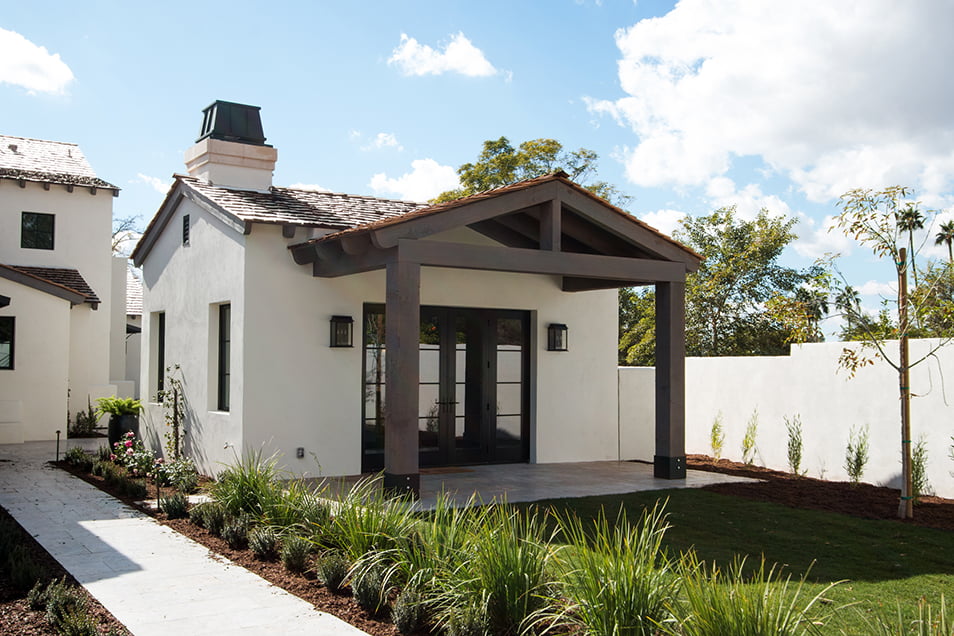Granny flats, in-law apartments, casitas; call them what you will — accessory dwelling units (ADUs) are surging in popularity across California.
An ADU is a secondary housing unit on a single family residential (SFR) lot. It can be attached to the primary house like a converted garage, or unattached like a freestanding cottage. Homeowners can create ADUs from new or existing structures.
These cozy dwellings have long been a popular way for seniors to age in place. But thanks to California’s housing crunch, ADUs have piqued the interest of residents of all ages across the state. Los Angeles saw the biggest influx of ADU applications, from 80 in 2016 to 1,980 in 2017, according to the Terner Center for Housing Innovation.
Because they are smaller and more affordable than traditional housing options, ADUs would help low- and moderate-income renters weather the Golden State’s skyrocketing housing costs. They add sorely needed density to SFR neighborhoods without materially altering their character. Most importantly, this density is controlled by local homeowners, not big developers.
Homeowner benefits
The density propelled by ADUs is an “invisible density” because it manifests in a homeowner’s backyard, not a mid-rise eyesore. But the benefits for both homeowners and renters are easy to see. Renters are searching for relief from high housing costs and ADUs can be an excellent investment for homeowners. It’s a win-win situation requiring minimal compromise.
For one, ADUs offer a stable rental income for homeowners who choose to rent their unit. Because demand has quickly outpaced new rental construction, rental vacancy rates are well below their historical equilibrium at 4.4%. Homeowners looking to build or repurpose a structure in their backyard, garage, home or basement will have little trouble finding competitive renters.
Homeowners will also find that adding an ADU is affordable, depending on the project. The average cost to build an ADU is $156,000, according to another Terner Center study on cities with permissive ADU regulations. Repurposing an existing structure like a garage or basement is even cheaper. To be fair, the study does not include California cities, so homeowners in the state should expect higher building costs.
Nevertheless, ADUs do not carry the added burden of California’s soaring land costs. An acre of land in coastal California — where the majority of jobs are — costs about eight times the U.S. average, according to the state Legislative Analyst’s Office. Since most homeowners already own the land on which they might build their ADU, they won’t have to clear this extra financial hurdle.
Though ADUs’ effects on property values are difficult to measure across markets and construction qualities, evidence suggests that they significantly increase property values. One study found that ADUs contributed between 25% and 34% of each property’s assessed value, according to The Appraisal Journal. Because this figure is highly variable, local agents and brokers are better suited to evaluate potential ADUs in their markets.
Barriers to ADU creation
Despite these benefits, many California cities are still hostile to ADUs. Zoning, permitting and costs are the biggest culprits.
Restrictive zoning policies have a history of stunting homeownership and home sales. For instance, many cities enforce parking requirements for homeowners building ADUs. Understandably, vocal not-in-my-backyard (NIMBY) activists don’t want to see parking in their neighborhoods become even more scarce. Similarly, NIMBYs claim increased density in general will also materially alter the character of their neighborhoods.
Aside from parking requirements, the prohibitive permitting process continues to hold back would-be ADU builders. Remember that ADU construction is largely driven by homeowners who aren’t as suited to navigating a costly, lengthy and complex permitting process as large-scale developers. If California wants to allow people to exercise their right as homeowners to build ADUs, it needs to streamline the permitting process.
Perhaps the tallest hurdle is cost. Though building an ADU is certainly far less expensive than a traditional SFR, financing options for ADU builders are limited. Large lenders are hesitant to fund these projects since they can’t place a lien on just the ADU and many cities enforce a deed restriction requiring ownership. Other lenders refuse to factor in the ADU’s future rental income, undervaluing the property. Without traditional financing options, ADU builders are filtered down to those who can afford to pay out of pocket or take out a mortgage against the main house or a reverse mortgage.
In addition to construction costs, impact fees are often overlooked costs that hurt ADU creation. These are fees paid to the city to offset the impact new residents will have on infrastructure. Think schools, roads, public services and the like. But across California, impact fees for ADUs are disproportionately high compared to those for traditional SFRs. Because owners renting their ADUs are likely to pass these fees on to renters, impact fees that go beyond a structure’s “fair share” prevent ADUs from becoming an affordable solution for low- and moderate-income renters.
ADU-friendly legislation
California lawmakers recognize ADUs’ potential to help alleviate the state’s housing crunch. The most noteworthy of recent legislative changes to ADU laws are parking requirement prohibitions. For many SFR neighborhoods resistant to density changes, this has become a sticking point. Key recently enacted, ADU-friendly laws include:
- Senate Bill 1069, which prohibits parking requirements if the ADU is within a half mile from public transit;
- Senate Bill 2299, which limits parking requirements to one space per unit or bedroom and provides maximum standards a local government is authorized to issue on ADUs (for example, an ADU may be built on a property zoned for SFR use only); and
- Senate Bill 2406, which allows junior ADU construction of no more than 500 square feet within an SFR and prohibits additional parking requirements.
Similar ADU-friendly legislation currently pending in the California legislature includes:
- Senate Bill 13, which prohibits parking replacement requirements for garage conversions, reduces impact fees levied on ADUs and streamlines the application and permitting process; and
- Assembly Bills 68 and 69, which speed up the application process and allow more types of ADUs.
These bills aim to lift regulatory barriers hampering ADU creation. Because of California’s immutable car culture, many ADU-friendly bills address parking requirements. While NIMBYs claim that parking will become scarce and change the character of their quiet SFR neighborhoods, progressive ADU legislation in other markets does not support this argument.
Given that ADUs and research on them are rare, one illuminating example can be found in Portland, Oregon. Because of its progressive zoning laws, Portland is the nation’s leader in ADUs and offers some insight into densifying. Here, ADUs have had a negligible effect on parking, according to an Oregon Department of Environmental Quality study. The average number of cars per dwelling was lower than the city’s average for all new rentals and only about half of those cars occupied street parking spaces.
Of course increased density will change a neighborhood; the question is to what degree this will occur. ADUs represent an acceptable compromise to California’s most pressing crisis. Yes, homeowners deserve to maintain the character of the neighborhood they bought into, but how can one justify such inflexibility and opposition to invisible density amid a crippling housing crisis?
Getting ahead of the curve
As trusted real estate professionals, agents are a homeowner’s first stop when thinking about building an ADU. Agents looking to maintain a strong and constant presence in their markets can familiarize themselves with laws and regulations controlling ADUs and offer consultations.
Editor’s note — Download first tuesday’s ADU FARM Letter here.
California needs greater housing density; the future of its economy depends on giving people more options for living near their workplaces and reining in suburban sprawl. ADUs are a small but effective step toward closing this housing gap in California. On a larger scale, California’s legislature has passed several other bills geared toward affordable housing. Follow the link to learn about legislation California lawmakers have enacted to fight back against the housing shortage.
Related article:















l live in West Palmdale on 2 1/2 acres of unincorporated land. Also zoned Agri2. Considered Los Angeles County. There was a grant program to help seniors and low income with a grant, will that happen in the near future? Please get back to me. Sincerely, Monica Chandler
Currently, most lending institutions that are looking for the value-add from an ADU, are only allowing
additional value to be given for these by using the Sales Comparison Approach using closed sales. Because this is a new thing in most cities,
there are very few sales of homes with ADU’s to extract the value from the market. So for now, “the true value that ADU’s contribute, is muted”
– Lawrence A. Walsh, The Real Estate Sales Advocate.com